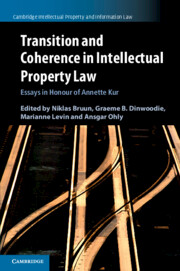Book contents
- Transition and Coherence in Intellectual Property Law
- Cambridge Intellectual Property and Information Law
- Transition and Coherence in Intellectual Property Law
- Copyright page
- Contents
- Preface
- Greetings to Annette Kur from the Second Floor
- Annette Kur: Toward Understanding
- Part I Transition
- Part II Coherence
- A Intellectual “Property” and its Limits
- B IP Overlaps
- 25 Intellectual Property in Transition: The Several Sides of Overlapping Copyright and Trademark Protection
- 26 Cultural Heritage and the Public Domain: What the US’s Myriad and Mayo can Teach Oslo’s Angry Boy
- 27 Public Order in the Light of Aesthetic Theory: The Copyright/Trademark Interface after Vigeland
- 28 Separability as Channeling: A Cautionary Tale
- 29 Novelty, Idea or New Meaning as Criteria for Copyright Protection? Transitions in Swedish Design Law
- 30 Examining Functionality
- 31 Substantial Value and the Concept of Shapes
- 32 Copyright and Patents on Software: The UPC’s Answer to an Old Problem of Intellectual Property Overlaps
- 33 Chopping off Hydra’s Heads: Spare Parts in EU Design and Trade Mark Law
- C (Un-)fairness
- Conclusion
- Cambridge Intellectual Property and Information Law
32 - Copyright and Patents on Software: The UPC’s Answer to an Old Problem of Intellectual Property Overlaps
from B - IP Overlaps
Published online by Cambridge University Press: 29 December 2020
- Transition and Coherence in Intellectual Property Law
- Cambridge Intellectual Property and Information Law
- Transition and Coherence in Intellectual Property Law
- Copyright page
- Contents
- Preface
- Greetings to Annette Kur from the Second Floor
- Annette Kur: Toward Understanding
- Part I Transition
- Part II Coherence
- A Intellectual “Property” and its Limits
- B IP Overlaps
- 25 Intellectual Property in Transition: The Several Sides of Overlapping Copyright and Trademark Protection
- 26 Cultural Heritage and the Public Domain: What the US’s Myriad and Mayo can Teach Oslo’s Angry Boy
- 27 Public Order in the Light of Aesthetic Theory: The Copyright/Trademark Interface after Vigeland
- 28 Separability as Channeling: A Cautionary Tale
- 29 Novelty, Idea or New Meaning as Criteria for Copyright Protection? Transitions in Swedish Design Law
- 30 Examining Functionality
- 31 Substantial Value and the Concept of Shapes
- 32 Copyright and Patents on Software: The UPC’s Answer to an Old Problem of Intellectual Property Overlaps
- 33 Chopping off Hydra’s Heads: Spare Parts in EU Design and Trade Mark Law
- C (Un-)fairness
- Conclusion
- Cambridge Intellectual Property and Information Law
Summary
Whereas most creations of the mind, such as works of literature, music and art, technical inventions and typical marks capable of distinguishing goods or services, are subject matters eligible for only one particular intellectual property right, some artefacts pose difficulties in terms of characterisation. The three-dimensional shape of goods may be protected by design, copyright or trademark law. Innovative plants can meet the requirements of either plant variety protection or that of biotechnological inventions. Computer programs may be protected as literary works under copyright law or as technical inventions under patent law. Annette Kur has worked intensively on those intellectual property overlaps, or cumulation, in the last twenty years since her seminal work published in a conference volume2 that gathered the presentations given on the occasion of the opening of the new building of the Max Planck Institute in Munich in the year 2000 – the first conference which the author of these lines ever attended at the Institute and which left a deep impression on him. In this early paper Annette Kur had already developed her general theory of intellectual property overlaps which she later explored in more detail for the field of trademark and design law.3 According to her theory, cumulation of intellectual property rights does not pose a problem per se as long as (1) the requirements of protection under the different legal regimes are formulated and applied so as to fully justify the protection granted, and (2) each one of the rights applied is adequately balanced in itself, in particular as regards the relationship between the requirements, the general scope of protection and the limitations. By contrast, if in the application of the different regimes, their protection requirements become more and more blurred whereas the differences are maintained in respect of the scope of protection and the limitations, the balance of the rights in question may be affected negatively, a phenomenon labelled by Annette Kur as “asymmetric convergence”,4 an expression that has been picked up by many later works on the subject.5 This chapter focuses on the overlap of copyright and patent protection in the field of computer programs. The issue is not a new one. It was addressed in Annette Kur’s first paper on the cumulation problem. What is new is the European legislator’s approach to the problem in Article 27 lit. k) of the United Patent Court (UPC) Agreement, which aligns, at least in part, the limitations and exceptions of copyright and patent law with regard to computer programs.
- Type
- Chapter
- Information
- Transition and Coherence in Intellectual Property LawEssays in Honour of Annette Kur, pp. 382 - 391Publisher: Cambridge University PressPrint publication year: 2021

